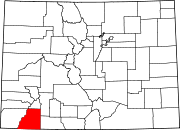
The Denver and Rio Grande Western Railroad, often shortened to Rio Grande, D&RG or D&RGW, formerly the Denver & Rio Grande Railroad, was an American Class I railroad company. The railroad started as a 3 ft narrow-gauge line running south from Denver, Colorado, in 1870. It served mainly as a transcontinental bridge line between Denver and Salt Lake City, Utah. The Rio Grande was also a major origin of coal and mineral traffic.

The Cumbres and Toltec Scenic Railroad, often abbreviated as the C&TSRR, is a 3 ft narrow-gauge heritage railroad that operates on 64 miles (103 km) of track between Antonito, Colorado, and Chama, New Mexico, in the United States. The railroad is named for two geographical features along the route: the 10,015-foot (3,053 m)-high Cumbres Pass and the Toltec Gorge. Originally part of the Denver and Rio Grande Western Railroad's narrow-gauge network, the line has been jointly owned by the states of Colorado and New Mexico since 1970. Today, the C&TSRR is one of only two remaining parts of the former D&RGW narrow-gauge network, the other being the Durango and Silverton Narrow Gauge Railroad (D&SNG), which runs between the communities of Durango and Silverton, Colorado. The railroad has a total of ten narrow-gauge steam locomotives and two narrow-gauge diesel locomotives on its current roster. The railroad also operates two smaller former D&RGW steam locomotives, Nos. 315 and 168, for special events and excursions.

The San Juan Skyway Scenic and Historic Byway is a 236-mile (380 km) All-American Road, National Forest Scenic Byway, and Colorado Scenic and Historic Byway located in Dolores, La Plata, Montezuma, San Juan, and San Miguel counties, Colorado, United States. The byway forms a loop in southwestern Colorado traversing the heart of the San Juan Mountains. The San Juan Skyway reaches its zenith at Red Mountain Pass at elevation 11,018 feet (3,358 m). Mesa Verde National Park was one of the original UNESCO World Heritage Sites. The Silverton Historic District and the Telluride Historic District are National Historic Landmarks.

The Durango and Silverton Narrow Gauge Railroad, often abbreviated as the D&SNG, is a 3 ft (914 mm) narrow-gauge heritage railroad that operates on 45.2 mi (72.7 km) of track between Durango and Silverton, in the U.S. state of Colorado. The railway is a federally-designated National Historic Landmark and was also designated by the American Society of Civil Engineers as a National Historic Civil Engineering Landmark in 1968.

The Ghost Town & Calico Railway is a 3 ft narrow-gauge heritage railroad and amusement park attraction within Knott's Berry Farm, an amusement park located in Buena Park, California.

The Rio Grande Southern Railroad was a 3 ft (914 mm) narrow-gauge railroad which ran in the southwestern region of the US state of Colorado, from the towns of Durango to Ridgway, routed via Lizard Head Pass. Built by German immigrant and Colorado toll road builder Otto Mears, the RGS operated from 1891 through 1951 and was built with the intent to transport immense amounts of silver mineral traffic that were being produced by the mining communities of Rico and Telluride. On both ends of the railroad, there were interchanges with The Denver and Rio Grande Railroad, which would ship the traffic the RGS hauled elsewhere like the San Juan Smelter in Durango.
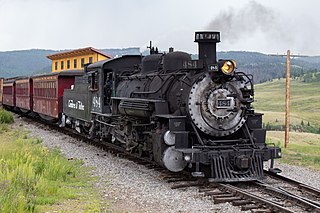
The Denver and Rio Grande Western K-36 is a class of ten 3 ft narrow gauge 2-8-2 "Mikado" type steam locomotives built for the Denver and Rio Grande Western Railroad (D&RGW) by Baldwin Locomotive Works. They were shipped to the Rio Grande in 1925 and were first used along the Monarch Branch and Marshall Pass, but were later sent to the Third Division out of Alamosa. Of the original ten, four are owned by the Durango and Silverton Narrow Gauge Railroad (D&SNG) and five by the Cumbres and Toltec Scenic Railroad (C&TSRR). Number 485 fell into the turntable pit at Salida and was scrapped in Pueblo in 1955, with many parts being saved.

The Denver and Rio Grande Western K-27 is a class of 3 ft narrow gauge 2-8-2 "Mikado" type steam locomotives built for the Denver and Rio Grande Railroad by the Baldwin Locomotive Works in 1903. Known by their nickname "Mudhens," they were the first and the most numerous of the four K classes of Rio Grande narrow gauge engines to be built. Of the original fleet of 15 locomotives, two survive to this day and operate on heritage railways in the United States. No. 463 is operational on the Cumbres and Toltec Scenic Railroad (C&TSRR) in Chama, New Mexico and No. 464 is currently out of service due to a rebuild on the Huckleberry Railroad in Genesee Township, Michigan.

Denver and Rio Grande is a 1952 American Technicolor Western film, directed by Byron Haskin and released by Paramount Pictures. The film is a dramatization of the building of the Denver and Rio Grande Railroad, which was chartered in 1870. It was filmed in the summer of 1951 on location on actual D&RG track near Durango, Colorado.

The Utah Division of the former Denver & Rio Grande Western Railroad (D&RGW) is a rail line that connects Grand Junction, Colorado and Salt Lake City, Utah in the Western United States. It is now incorporated into the Union Pacific Railroad (UP) system as part of the Central Corridor. The modern Union Pacific has split the line into two subdivisions for operational purposes, the Green River Subdivision between Grand Junction and Helper, Utah and the Provo Subdivision from Helper to Salt Lake City. Daily passenger service is provided by Amtrak's California Zephyr; the BNSF Railway and Utah Railway have trackage rights over the line.

The Denver and Rio Grande Western K-37 is a class of 2-8-2 "Mikado" type narrow-gauge steam locomotives built for the Denver and Rio Grande Western Railroad. They were new steam locomotives built in the D&RGW Burnham Shops as a near copy of the Rio Grande class K-36. In-house production was chosen to preemptively address material shortages and personnel issues. Burnham Shops was assisted in the construction of the class by the Stearn-Rogers Manufacturing Company. The class recycled components from Baldwin Locomotive Works-built Class 19 2-8-0 locomotives used on the Rio Grande's standard gauge; re-using the boiler, tender and other components salvaged from the C-41's. The engine components were constructed new for the locomotive class.

The Denver and Rio Grande Western K-28 is a class of ten 3 ft gauge narrow gauge 2-8-2 "Mikado" type steam locomotives built in 1923 by the Schenectady Locomotive Works of the American Locomotive Company (ALCO) for the Denver & Rio Grande Railroad. They were the first new narrow gauge locomotives ordered by the railroad since 1903. They initially comprised class E-4-148-S, but were reclassified K-28 in 1924 when the railroad reorganized into the Denver & Rio Grande Western Railroad.
The Chili Line, officially known as the Santa Fe Branch, was a 3 ft narrow-gauge branch of the Denver and Rio Grande Western Railroad (D&RGW). It ran 125.6 miles (202.1 km) from Antonito, Colorado, to Santa Fe, New Mexico. The Denver and Rio Grande Railway (D&RG) began construction of the line in 1880 and completed the line from Antonito to Española, New Mexico, but could not build any further because of an agreement with the Atchison, Topeka and Santa Fe Railroad (AT&SF). The Texas, Santa Fe and Northern Railroad was incorporated to complete the line, and the line between Española and Santa Fe opened in 1886 and was transferred to the Denver and Rio Grande shortly thereafter. The D&RGW closed the Chili Line in 1941 because of competition from road transportation, and the line was abandoned shortly thereafter.
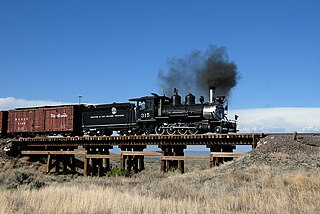
Denver and Rio Grande Western No. 315 is a class "C-18" 2-8-0 "Consolidation" type narrow-gauge steam locomotive that was originally built for the Florence and Cripple Creek Railroad by the Baldwin Locomotive Works in 1895. It was purchased by the Denver and Rio Grande Railroad (D&RG) in 1917 and later became known as No. 315. It was retired in 1949 and had been on display at City of Durango parks until the Durango Railroad Historical Society restored the locomotive from 2001 to August 2007. It was operational from then until September 2021. On March 8, 2023, it has returned to service, following its FRA federally mandated 1,472-day boiler inspection and overhaul. Most "sister" locomotives to No. 315 were scrapped, but two others survive today: D&RGW No. 318, on display at the Colorado Railroad Museum; and F&CC No. 10, currently in storage at the Nevada Southern Railroad Museum.
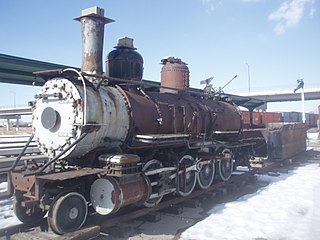
Denver and Rio Grande Western 223 is a 2-8-0 "Consolidation" type narrow-gauge steam locomotive built for the Denver and Rio Grande Western Railroad by the Grant Locomotive Works of Paterson, New Jersey in 1881–82. Number 223 was completed in December 1881, at a cost of $11,553. Rio Grande 223 is the only surviving narrow-gauge engine built by Grant Locomotive Works. D&RGW 223 and the other Class 60 engines were part of the Rio Grande's expansion into Colorado and Utah in the 1880s.
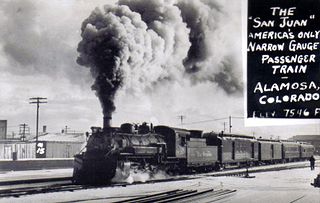
The San Juan Express was a narrow gauge train that ran on the 3 feet (0.91 m) Denver & Rio Grande Western Railroad (D&RGW) route from Durango, Colorado via Chama, New Mexico; Cumbres Pass; and Antonito, Colorado to Alamosa, Colorado. The train ran from February 11, 1937 until January 31, 1951 as train numbers 115 and 116, though towards the end of the passenger service it took on the number 215 and 216.
Sublette is a railroad ghost town in northern Rio Arriba County, New Mexico, United States, built as a section station in 1880. It is located north-east of Chama, just south of the Colorado state line and at milepost 306.1 of the former Denver and Rio Grande Western Railroad. When the Denver and Rio Grande abandoned its narrow gauge lines in the late 1960s, two parts of the system were preserved independently: the Cumbres & Toltec Scenic Railroad from Antonito to Chama, including Sublette itself, and the Durango and Silverton Narrow Gauge Railroad. Sublette sits at an elevation of 9,281 feet in the southeastern San Juan Mountains.

The Alamosa–Durango line or San Juan extension was a railroad line built by the Denver and Rio Grande Western Railroad, following the border between the U.S. states of Colorado and New Mexico, in the Rocky Mountains. The line was originally built as a 3 ft narrow-gauge line between Alamosa, Colorado, and Durango, Colorado. Portions of the route survive: the now standard-gauged segment from Alamosa to Antonito, Colorado, and a narrow-gauge portion from Antonito to Chama, New Mexico.
The Tracks Across Borders Scenic and Historic Byway is an 89-mile (143 km) Colorado Scenic and Historic Byway located in La Plata and Archuleta counties, Colorado, USA. From Durango, Colorado, the southern terminal of the Durango and Silverton Narrow Gauge Railroad, a National Historic Landmark, the byway follows the roadbed of the historic narrow-gauge Denver and Rio Grande Western Railroad through the Southern Ute Indian Reservation to the New Mexico state line. At the state line, the byway connects with the 9.9-mile (16 km) Narrow-Gauge Scenic Byway which continues on through the Jicarilla Apache Indian Reservation to Dulce, New Mexico. New Mexico plans to continue the byway on to Chama, New Mexico, the southern terminal of the Cumbres and Toltec Scenic Railroad, another National Historic Landmark, reconnecting the historic railway between Antonito, Colorado and Silverton, Colorado.
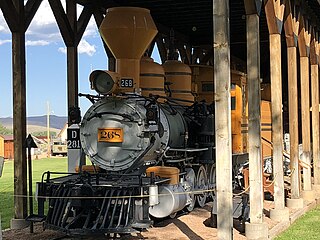
Rio Grande 268 is a 2-8-0 "Consolidation" type narrow-gauge steam locomotive built for the Denver and Rio Grande Western Railroad by the Baldwin Locomotive Works in 1882. It is one of three surviving locomotives in D&RG class 60.























